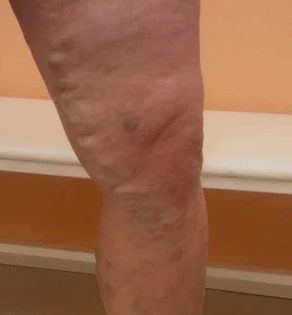
Varicose veins - This is the expansion of subcutaneous veins with a diameter of more than 3 mm.Varicose veins arise due to the impaired operation of the venous flaps and the weakness of the venous wall;At the same time, the blood drainage takes place from the lower extremities, a pressure climb in the vein, which can lead to chronic venous insufficiency.
Sometimes teleanggiektasia and reticular veins are confused with seizures.
These are veins with diameter 3 mm and lessThey do not influence the venous outflow, but cause a clear cosmetic defect.
What is the prevalence of varicose veins?
There is a varicose expansion of subcutaneous veins in 30 % of women and 15 % of men in mature age.The prevalence of varicose veins of the lower extremities increases significantly with age and is available in most people over 60 years.The proportion of patients with trophic diseases in adulthood is only 1.8%, while the indicator reaches 20%between the ages of age.At the same time, every fifth patient is in life with thrombophlebitis.Among the reasons that lead to disabilities, the proportion of disabled forms of veins of veins is more than arteries.
The main risk factors for the development of varicose veins are:
- older age
- Female gender
- pregnancy
- Hormonal disorders
- Positive family history
Additional risk factors:
- Smoke
- Arterial hypertension
- constipation
The literature on additional risk factors is contradictory.In addition, the risk of venous disease is low.
How manifests varicose veins?

The most common manifestation is unevenly expanded veins that protrude above the surface.In some cases, they can hardly be conspicuous or only determined by touching, in others they accept a diaper shape with the formation of nodes or in the appearance of a large grape heap.
Varicose veins are often accompanied by the following symptoms:
- Feeling and tension in the legs
- Pain pain and/or pain along the veins
- Fast tiredness of the legs
- Itching the skin of the legs
A rare disease can cause a restless leg syndrome and the nightly leg cramps.
What are the dangers of progression of varicose veins?
In the absence of treatment, the progression of varicose veins can lead to chronic venous insufficiency (CVN).The presence of HVN indicates serious violations of the venous lymph return (clinical classes C3-C6 CEAP classification), including: chronic edema (lymphedem), skin color (hyperpigmentation), venous eczema, skin packaging, trophic venous ulcer.
What are the complications of varicose veins?
Thromboflebititis of a thrombus in a surface venous system is an event that is exposed to 20% of patients with varicose veins.Such thrombosis is accompanied by severe pain, reddening of the skin, sealing along the veins on the lower leg and/or the thigh.In the absence of treatment, thrombotic masses are possible for a deep venous system.

Deep venous thrombosis (TGV) - In most cases, the beginning of the process is asymptomatic.When the thrombosis spreads to the femoral segment and the vein of the pelvis, the main drainage of blood from the lower extremities is disturbed, which is accompanied by severe edema and pain syndrome and is regarded as a life-threatening situation.
Tromboembolism of the lung arteries (Tela) - In 10% of cases, thrombotic masses are fragmented in deep veins of the lower extremities and emigrated to the pulmonary arteries with blood flow, which leads to deaths.
What is required for the right diagnosis?
In view of the multitude of forms of venous diseases, every detail of the history of the development of the illness and the life of the patient, the presence of simultaneous diseases, transactions, the result of an external examination of a doctor and the most important thing is that ultrasound ultrasonic scan -scan -scan -scan diagnosis with ultrasound, correct diagnosis.The latter is today the most informative and non -invasive method for examining the veins of the lower extremities.
Varicose vein treatment, the most common methods:
- Medicines with medication -related drugs have proven their effectiveness in reducing the symptoms of varicose veins, but are not able to remove varicose veins themselves.Pharmacotherapy is used successfully to prevent complications in risk groups, preoperative preparation and postoperative rehabilitation.
- Compression treatment - Special medical knitting clothes in the form of golf, stocking, pantyhose.In some cases, multi -layer bandages with elastic bandages of various extensions and hardware pneumo compression are used.The role of compression treatment is difficult to overestimate, it is present in almost every stage of prevention and treatment of chronic veins.
- Introduction to the lumens of the veins of the drugs, which can lead to closure.This method is a gold standard for the elimination of reticular veins.It is successfully used in the treatment of varicose veins with a large diameter and has restrictions on eliminating the pathological blood flow of the most important subcutaneous veins.
- Classic operation - A combined phlebectomy is carried out on an outpatient basis in the modern performance under vertebral or local anesthesia.In some cases, this is the only feasible way if the target veins are very convincing and/or have high extensions.However, the method is inferior to the vascular traumatic process of endo procedures.
- Endo venous laser prison - A method for the treatment of varicose veins, in which the vein is not removed, but is closed from the inside with the energy of the laser radiation, which is brought directly into the vessel of wholesale.The effectiveness of the procedure is comparable to the results of the surgical removal of the veins, at the same time it is characterized by minimal trauma.The rehabilitation period is 1-3 days.
- Radio frequency prison - A progressive method to eliminate the pathological blood flow of subcutaneous stammer.This is a completely outpatient procedure that is carried out under local anesthesia.The effectiveness of the treatment corresponds to the degree of classic phlebectomy, pain syndrome is minimal or missing.The rehabilitation period is 1-2 days.














































